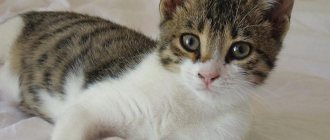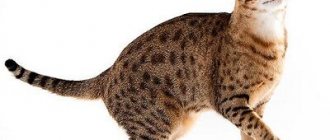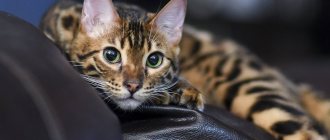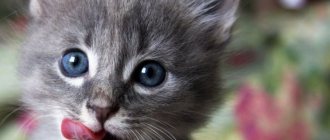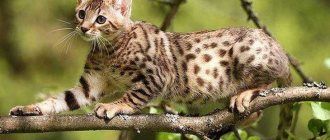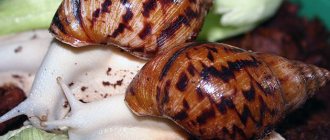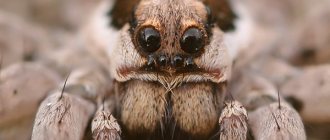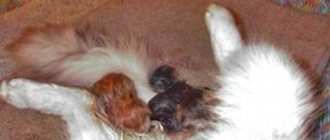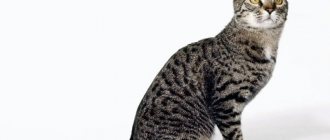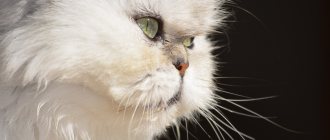This unique breed has many advantages that a person may not even be aware of. The photo of an oriental cat does not look quite ordinary.
At first glance, the appearance of thin cats with long ears may seem comical, but in fact, representatives of this breed have a wonderful character that owners cannot help but like.
A little history
In the 19th century, the Siamese cat became a guest at an English exhibition, where its appearance became a real sensation.
Later, breeders began crossing Siamese with female shorthaired breeds. This is how the Oriental cat breed was developed.
Pros and cons of the breed
According to reviews from owners, the Oriental breed has many advantages, but there are also disadvantages, if you can call them that.
Good companion
Gets along well with children and other animals
Loving, affectionate, gentle
Easy to learn and trainable
Very talkative, she will definitely insert her meow on every occasion
Can be annoying, as it follows the owner's heels
Unable to remain alone for long periods of time
Breed standard
- Torso. The animal is of medium size and has a thin constitution. Its body is elongated with well-developed muscles, its tail is thin, and its legs are high.
- Head. The breed is characterized by a flat forehead, a thin and elongated nose, and a narrowed chin. The muzzle has an elongated, wedge-shaped shape.
- Ears. They are large in size, with a wide base that becomes pointed at the ends.
- Eyes. Slanting, almond-shaped, green.
- Wool cover. The coat is short and shiny, there is no undercoat.
- Color. All kinds of varieties except white.
Health
Shorthaired Orientals and Mandarins have excellent health and strong immunity. But there is still a predisposition to certain diseases:
- Gingivitis is an inflammation of the gums that, without timely treatment, develops into periodontal disease.
- Cardiomyopathy is a heart disease in which the walls of the ventricle harden. The volume of the heart chambers decreases, which leads to the development of heart failure.
- Retinal atrophy is a hereditary defect in which the visual cells of the retina are destroyed, which leads to partial or complete blindness. The disease occurs both at a young age (3-4 months) and at a later age (after 4-5 years).
- Flat chest syndrome is a hereditary pathology. The chest becomes flat or funnel-shaped. The problem is identified immediately after the kitten is born.
Characteristics of a pet
An owner who wants to get a pet will need the following information: the character and description of the oriental cat.
These energetic animals have a good disposition. Cats are trusting of people and quickly become attached to them. If the owner takes care of his pet, then he will always be surrounded by boundless love.
A sociable cat requires a lot of attention. If a person is constantly busy, he should not choose such a pet. Or he can get a couple of cats at once; the two animals will not be bored.
Among the characteristics of the breed, one can note a gentle voice; pets love to talk with people. Cats are always in a great mood and are ready to play with their owner as soon as he has free time.
Adult pets remain energetic and active throughout their lives. If you take a kitten into your home, it quickly finds a common language with other pets.
Choosing and caring for kittens
Before purchasing a pet, you should find out how much an Oriental breed kitten costs. Their prices can vary greatly in different regions. Also, the price will depend on the class of the animal, its color, and parents.
The Oriental kitten is an inexhaustible source of energy. Therefore, when choosing a baby, you should pay attention to his behavior. The cat should be active, playful and affectionate, and should be easy to make contact with humans. Oriental kittens quickly adapt to new people, which allows you to understand the character (aggression, communication) of a particular animal in action.
Often, having bought an Oriental cat, people think about what nickname is best to come up with. The peculiarity of hearing implies names for pets containing hissing and growling sounds. This name will be easy for your cat to remember.
Caring for Oriental kittens is not particularly difficult. They quickly get used to the toilet, are not picky about food and have an easy-going character.
Oriental cats are an exotic breed that is very easy to care for. At the same time, they give a lot of positive emotions to any person. Loyalty and affection make these animals incomparable friends of man.
How to care for your pet
Owners should not devote much time to representatives of this breed. Short hair is easy to comb; you should start brushing from the head towards the tail.
It is recommended to bathe cats for preventive purposes. This needs to be done every year.
Appearance and standards
Orientals have a variety of coat colors, and in most cases they have green eyes. Nevertheless, they stand out among other felines due to their deceptive fragility, glossy beauty and the enchanting gaze of their slanted eyes. Elongated features and some angularity of the body add elegance to them.
According to the standards, the dimensions of the body are embodied in the following average indicators:
- the weight of a cat varies from 2.5 to 3.5 kg, and that of a cat – up to 4.5 kg;
- body height at the withers is approximately 20-25 cm;
- body length with tail reaches 90 cm;
- normal weight for a female is 2.3-3.2, and for a male – 3.7-4.5 kg, sometimes up to 6-8 kg.
Excess weight is contraindicated for such pets, as it can greatly worsen their health. Well-developed muscles are the key to the activity and health of the animal, as well as one of the distinctive features of the species.
Head and muzzle
The triangular head of an oriental cat corresponds to the following parameters:
- Elongated muzzle with a narrow chin and flat forehead. Connects to the body with a thin long neck.
- The eyes are of medium size, inclined towards the nose, have an almond-shaped cut, without strabismus. The color ranges from light to dark green and even marsh green, blue in white cats, heterochromia is allowed.
- A straight, elongated nose continues the line of the forehead, and at the end it visually connects straight to the line of the chin. Snub nose is a defect, as are dimples between the eyes.
- The ears are large and wide at the base, tapering and rounding towards the tips. Planted low and spaced apart. They are a natural extension of the head, bringing its shape closer to an equilateral triangle.
Body type
It’s not for nothing that the Oriental has the grace of a panther; this is due to the following structural features of the body:
- a torso with a thin skeleton, well-developed muscles and a toned abdomen;
- cartilage protrudes noticeably on the chest;
- the limbs are slender and strong, ending in miniature paws, the hind limbs are longer;
- the long tail tapers towards the end.
Coat and colors
Initially, Oriental cats were smooth-haired, with shiny, tight-fitting hair. They can have any color, in a color range of up to 300 shades, which were grouped into the following color groups:
- ebony (black);
- Havana (chocolate);
- lilac (pink-gray, lavender shade);
- blue (gray, silver);
- faun (light gray with beige);
- red (red);
- cream or cinnamon (light brown);
- white (rarest).
In addition, there are the following color variations:
- solid one color;
- bicolor (almost half and white);
- harlequin (white with large spots of color);
- van (snow-white, with small spots on the head and tail);
- Siamese (cream base with dark ears, muzzle and legs);
- tabby (brindle, spotted, marbled, ticked types);
- smoky (the light undercoat is shaded on top);
- tortoiseshell (primary color with red or cream shades);
- calico (chocolate tortoiseshell with white).
Long-haired Oriental cats: a new breed or a recognized variety?
At the end of the last century, breeders bred longhaired Orientals. As a result, their lines softened and their features became cuter, less like a predator and more like a pet. But felinological organizations recognized them only partially:
- TICA (Traditional Owners in America) calls them a variety of Oriental cats;
- FIFE (International Felinological Organization) and CFA (Cat Fanciers' Association) distinguish them into a separate breed, the Javanese;
- some American associations compare them to the Balinese, and the British - to the Siamese.
Oriental and Siamese cat
Orientals are descended from Siamese and are often crossed with each other to improve their characteristics. This produces a mixed litter, whereas two Siamese will only produce Siamese.
It is quite simple to distinguish them: the Oriental Siamese has green eyes, which is the main distinguishing feature.
Only snow-white cats will have blue eyes, like Siamese. Otherwise, they are all green-eyed, although individuals with different iris colors are less common. Previously, felinologists considered this a marriage, but since then the requirements have been revised.
How to take care of your eyes
Orientals wipe their eyes daily to remove all discharge.
The procedure is performed using a cotton swab or a piece of soft material, which is pre-moistened in water or tea leaves.
Mating
Mating an Oriental cat is a responsible process. The owner will have to:
- try to choose the right partner;
- calculate the optimal mating time;
- create an appropriate atmosphere.
If the purpose of mating is high show-class offspring, the partner must be appropriate. But even with complete compatibility of an Oriental cat and a female cat, there is no 100% guarantee of getting show kittens in the litter.
Professional Oriental breeders feel the potential of an animal from an early age and can immediately tell which animal has prospects for further breeding and which is destined for a pleasant fate as a pet.
How to care for your ears
The animal's huge ears require special attention. An oriental black cat or a pet with a different color has delicate skin, so rough manipulations are not acceptable.
For the cleaning procedure, prepare soft cotton swabs intended for hygiene procedures, Vaseline or oil. Do not make rough movements or press on the ears.
Character
The unique, completely inimitable character of oriental cats deserves special attention. They are smart, intelligent, affectionate and very affectionate to their family, curious and playful. They remain interested in various kinds of fun until old age. Orientals love to be the center of attention and can even be pushy to some extent. Possessing inexhaustible energy, they will take part in any household chores, be it cleaning or washing dishes. What they have a hard time with is loneliness, oriki get very bored when left alone for a long time, and if the cat is not given attention in the family, its character changes not for the better.
In order for all the positive qualities to fully manifest themselves, it is important that the kitten does not lack communication and love from birth.
Oriental cats are flexible and trusting. As a rule, they are strongly attached to one person. They are distinguished by their tolerance towards small children and a calm attitude towards their “affections”. Oriental cats are very smart, easy to train, love intellectual games and fetch different objects. Among other things, they are very emotional and talkative. These qualities are especially important to consider for people who prefer silence. The eastern kitty will talk always and everywhere, will voice many of its actions, and can change the tonality and pitch of sound to express different feelings and needs.
When purchasing a cat, you need to be prepared for diverse moments in life together, both positive and negative, and also remember that the right relationship is based on love and mutual understanding.
How to care for claws
It is recommended to cut your nails every month. To avoid causing pain to your pet, you should trim a maximum of 2 mm.
For the procedure, use sharp nippers; accustom the kitten to nail hygiene from the moment it appears in your home; trim one nail per week.
Care
Due to the lack of undercoat, shorthaired Oriental cats do not require special coat care. During the molting period, it is enough to brush them once a week with a special rubber mitten or a brush with natural bristles. Orientals are very clean and do not need regular bathing. Therefore, the main task of the owner is to monitor the cleanliness of the eyes, ears and the condition of the oral cavity.
Contents of orientals
Before you get a pet, you will need to make sure that the cat has everything it needs. Your pet needs a place to sleep.
Buy a suitable cat house, toilet, toys, scratching post, and special care products for him.
What to feed your pets
It is necessary to ensure that the diet is of high quality. You should not give your cat food from the table. His food should not be too spicy or too salty.
Siberian cat - history of the breed, description, character and habits + 95 photos- Maine Coon - history of occurrence, description of the breed, character + 84 photos
- Burma - a cat as a mascot, hygiene and health, character of the breed + 96 photos
Fatty foods are harmful to Orientals. Premium ready-made food is a balanced menu that will benefit your pets.
The animal must be fed at least 2 or 3 times a day. If you want to wean your pet off food, do it gradually. Pour new food into his bowl along with the old one, increasing the dose of the first over time.
How to choose a kitten
When choosing and purchasing a purebred Oriental kitten, it is important to know:
- The breeder will not give away the kitten until it is 3 months old. If they sell smaller kittens, this is a reason to think about it.
- Each purebred kitten must have a birth certificate (birth certificate) or pedigree if it is a show kitten. A pet without documents is not a real Oriental.
If you have doubts whether the litter has been registered, you can always check with the club in which the nursery is listed.
At the age of 2 months, the litter is assessed (actuation). Kittens are divided into 2 categories: those who participate in further breeding and those who do not. The cost of the kitten depends on this. On average, it starts from 20 thousand rubles.
There are too many factors that influence the price. The main one is the type of kitten. The extreme type is valued higher - eared, with a long muzzle, thin bones, and very short hair. All breeders strive to get just such kittens. The price for them starts from 40 thousand rubles. Of course, the cost is determined by color, quality (the presence of defects reduces the cost), and the purpose of purchase (for breeding or castration). Therefore, the price for a kitten as a pet can be 100 thousand rubles, and with the right of breeding 120 thousand and more.
